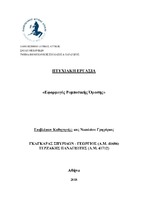| dc.contributor.advisor | Νικολάου, Γρηγόριος | |
| dc.contributor.author | Τερζάκης, Παναγιώτης | |
| dc.contributor.author | Γκαγκάρας, Σπυρίδων-Γεώργιος | |
| dc.date.accessioned | 2018-07-24T08:04:50Z | |
| dc.date.available | 2018-07-24T08:04:50Z | |
| dc.date.issued | 2018-07-09 | |
| dc.identifier.uri | http://okeanis.lib2.uniwa.gr/xmlui/handle/123456789/4543 | |
| dc.description.abstract | Στην παρούσα εργασία παρουσιάζονται δύο συστήματα ρομποτικής όρασης. Το πρώτο σύστημα αφορά την ανίχνευση και την αναγνώριση προσώπου σε πραγματικό χρόνο. Το δεύτερο σύστημα αφορά την ανίχνευση και τον έλεγχο της στάθμης υγρού σε μπουκάλι καθώς και τον υπολογισμό των χιλιοστογραμμαρίων του υγρού που περιέχονται κάθε φορά σε αυτό. Στόχος και στις δύο εφαρμογές είναι η μέγιστη δυνατή αποτελεσματικότητα με το χαμηλότερο δυνατό κόστος. Στο πρώτο μέρος της πτυχιακής εργασίας αναλύονται οι απαραίτητες θεωρητικές έννοιες στις οποίες βασίστηκαν οι συγγραφείς για την τεκμηρίωση της έρευνάς τους. Συγκεκριμένα, αξιοποιήθηκαν οι μέθοδοι των Viola & Jones στην ανίχνευση προσώπου, τα Τοπικά Δυαδικά Πρότυπα στην αναγνώριση προσώπου, ενώ η ανίχνευση της στάθμης έγινε με βάση την Εικόνα Ακρών. Στη συνέχεια, παρουσιάζονται τα υλικά που αξιοποιήθηκαν στην έρευνα και ο σκοπός χρήσης τους. Παρατίθενται οι κώδικες που αναπτύχθηκαν για τις δύο εφαρμογές ρομποτικής όρασης και σχολιάζονται οι συναρτήσεις που χρησιμοποιήθηκαν μέσω της βιβλιοθήκης OpenCV και της γλώσσας προγραμματισμού Python. Στην ενότητα των αποτελεσμάτων, παρουσιάζονται φωτογραφίες από την εφαρμογή των δύο κωδίκων και επεξηγούνται. Έμφαση δίνεται στα συμπεράσματα από την εφαρμογή των κωδίκων. Συζητούνται οι προϋποθέσεις επιτυχίας της έρευνας, οι δυσκολίες που συναντήθηκαν καθώς και οι τρόποι με τους οποίους αυτές ξεπεράστηκαν. Τέλος, αναφέρονται κάποιοι τομείς στους οποίους θα μπορούσαν να έχουν εφαρμογή τα συστήματα της πτυχιακής εργασίας. | el |
| dc.format.extent | 82 | el |
| dc.language.iso | el | el |
| dc.publisher | Α.Ε.Ι. Πειραιά Τ.Τ. | el |
| dc.rights | Αναφορά Δημιουργού-Μη Εμπορική Χρήση-Όχι Παράγωγα Έργα 3.0 Ελλάδα | * |
| dc.rights.uri | http://creativecommons.org/licenses/by-nc-nd/3.0/gr/ | * |
| dc.subject | TPSH::Τεχνολογία::Αυτόματος Έλεγχος::Ρομποτική | el |
| dc.title | Εφαρμογές ρομποτικής ορασης | el |
| dc.title.alternative | Robotic vision applications | el |
| dc.type | Πτυχιακή εργασία | el |
| dc.contributor.committee | Δρόσος, Χρήστος | |
| dc.contributor.committee | Βασιλειάδου, Σουλτάνα | |
| dc.contributor.committee | Νικολάου, Γρηγόριος | |
| dc.contributor.department | Τμήμα Μηχανικών Αυτοματισμού Τ.Ε. | el |
| dc.contributor.faculty | Σχολή Τεχνολογικών Εφαρμογών | el |
| dc.subject.keyword | Ρομποτική όραση | el |
| dc.subject.keyword | Python | el |
| dc.subject.keyword | Ανιχνευτές προσώπων | el |
| dc.subject.keyword | OpenCV | el |
| dc.subject.keyword | Γλώσσα προγραμματισμού Python | el |
| dc.description.abstracttranslated | In the present study two applications of robotic vision are presented. The first system aims at face detection and recognition in real time. The second system aims at the detection and control of the liquid level in a bottle as well as the estimation of the liquid’s milligrams that are contained in it. The basic goal for both applications is the maximum efficiency with the lowest possible cost. In the first part of this diploma study, the necessary theoretical concepts, on which the authors documented their research, are explored. More specifically, the authors deployed the method of Viola & Jones for face detection, the Local Binary Patters for face recognition and the control of the liquid level was achieved through the Edge Image. Then, the materials used and their goal of use is presented. The codes that were developed for both systems are cited. Also, the functions used through the OpenCV library and the programming language Python are explored. In the section of Results, photos of the implementation of the codes are presented and explained. Emphasis is placed on the conclusions from the implementation of the codes. The conditions that would ensure the success of this research are discussed along with the difficulties faced and the ways that they were surpassed. Finally, some applications to which the systems developed in this diploma research could be applied are mentioned. | el |


